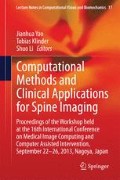Abstract
Due to its high flexibility, the spinal cord is a particularly challenging part of the central nervous system for the quantification of nervous tissue changes. In this paper, a novel semi-automatic method is presented that reconstructs the cord surface from MR images and reformats it to slices that lie perpendicular to its centerline. In this way, meaningful comparisons of cord cross-sectional areas are possible. Furthermore, the method enables to quantify the complete upper cervical cord volume. Our approach combines graph cut for presegmentation, edge detection in intensity profiles for segmentation refinement, and the application of starbursts for reformatting the cord surface. Only a minimum amount of user input and interaction time is required. To quantify the limits and to demonstrate the robustness of our approach, its accuracy is validated in a phantom study and its precision is shown in a volunteer scan–rescan study. The method’s reproducibility is compared to similar published quantification approaches. The application to clinical patient data is presented by comparing the cord cross-sections of a group of multiple sclerosis patients with those of a matched control group, and by correlating the upper cervical cord volumes of a large MS patient cohort with the patients’ disability status. Finally, we demonstrate that the geometric distortion correction of the MR scanner is crucial when quantitatively evaluating spinal cord atrophy.
Access this chapter
Tax calculation will be finalised at checkout
Purchases are for personal use only
Notes
- 1.
- 2.
Note that this is not the same value as the \(0.67~{\mathrm {mm^{2}}}\) reported by Horsfield et al. [6] in a similar argument for the C2–C5 region, as they describe the CV of average CSAs, while we describe an average CV over slice-wise CSAs here. If we do the same calculation for our method with the C1–C3 average CSA (see Table 2, E2), assuming a CSA of \(78~{\mathrm {mm^{2}}}\) as reported in [6], the detectable change even drops to \(0.43~{\mathrm {mm^{2}}}\).
References
Alyassin, A.M., Lancaster III, J.L., Downs, J.H., Fox, P.T.: Evaluation of new algorithms for the interactive measurement of surface area and volume. Med. Phys. 21(6), 741–752 (1994)
Bakshi, R., Dandamudi, V.S.R., Neema, M., De, C., Bermel, R.A.: Measurement of brain and spinal cord atrophy by magnetic resonance imaging as a tool to monitor multiple sclerosis. J. Neuroimaging 15, 30S–45S (2005)
Boykov, Y.Y., Jolly, M.P.: Interactive graph cuts for optimal boundary & region segmentation of objects in n-d images. In: Eighth IEEE International Conference on Computer Vision, 2001. ICCV 2001. Proceedings, vol. 1, pp. 105–112 (2001)
Coulon, O., Hickman, S.J., Parker, G.J., Barker, G.J., Miller, D.H., Arridge, S.R.: Quantification of spinal cord atrophy from magnetic resonance images via a b-spline active surface model. Mag. Reson. Med. 47(6), 1176–1185 (2002)
Dierckx, P.: Algorithms for smoothing data with periodic and parametric splines. Comput. Graph. Image Process. 20(2), 171–184 (1982)
Horsfield, M.A., Sala, S., Neema, M., Absinta, M., Bakshi, A., Sormani, M.P., Rocca, M.A., Bakshi, R., Filippi, M.: Rapid semi-automatic segmentation of the spinal cord from magnetic resonance images: application in multiple sclerosis. NeuroImage 50(2), 446–455 (2010)
Jovicich, J., Czanner, S., Greve, D., Haley, E., van der Kouwe, A., Gollub, R., Kennedy, D., Schmitt, F., Brown, G., MacFall, J., Fischl, B., Dale, A.: Reliability in multi-site structural MRI studies: effects of gradient non-linearity correction on phantom and human data. NeuroImage 30(2), 436–443 (2006)
Losseff, N.A., Webb, S.L., O’Riordan, J.I., Page, R., Wang, L., Barker, G.J., Tofts, P.S., McDonald, W.I., Miller, D.H., Thompson, A.J.: Spinal cord atrophy and disability in multiple sclerosis. Brain 119(3), 701–708 (1996)
Miller, D.H., Barkhof, F., Frank, J.A., Parker, G.J.M., Thompson, A.J.: Measurement of atrophy in multiple sclerosis: pathological basis, methodological aspects and clinical relevance. Brain 125(8), 1676–1695 (2002)
Reynolds, R., Roncaroli, F., Nicholas, R., Radotra, B., Gveric, D., Howell, O.: The neuropathological basis of clinical progression in multiple sclerosis. Acta Neuropathol. 122(2), 155–170 (2011)
Tustison, N., Avants, B., Cook, P., Zheng, Y., Egan, A., Yushkevich, P., Gee, J.: N4ITK: improved n3 bias correction. IEEE Trans. Med. Imaging 29(6), 1310–1320 (2010)
Weier, K., Pezold, S., Andelova, M., Amann, M., Magon, S., Naegelin, Y., Radue, E.W., Stippich, C., Gass, A., Kappos, L., Cattin, P., Sprenger, T.: Both spinal cord volume and spinal cord lesions impact physical disability in multiple sclerosis. Multiple Sclerosis J. 19(Suppl), 188–189 (2013)
Acknowledgments
This work was supported by the MIAC Corporation, University Hospital Basel, Switzerland.
Author information
Authors and Affiliations
Corresponding author
Editor information
Editors and Affiliations
Rights and permissions
Copyright information
© 2014 Springer International Publishing Switzerland
About this paper
Cite this paper
Pezold, S. et al. (2014). A Semi-automatic Method for the Quantification of Spinal Cord Atrophy. In: Yao, J., Klinder, T., Li, S. (eds) Computational Methods and Clinical Applications for Spine Imaging. Lecture Notes in Computational Vision and Biomechanics, vol 17. Springer, Cham. https://doi.org/10.1007/978-3-319-07269-2_13
Download citation
DOI: https://doi.org/10.1007/978-3-319-07269-2_13
Published:
Publisher Name: Springer, Cham
Print ISBN: 978-3-319-07268-5
Online ISBN: 978-3-319-07269-2
eBook Packages: EngineeringEngineering (R0)

